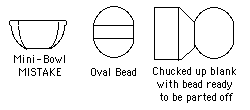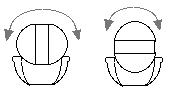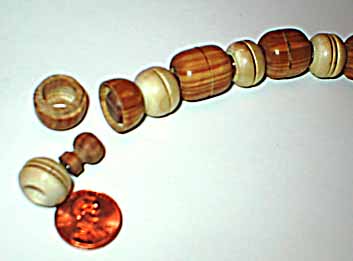Where Do Ideas Come From? Genesis Of An Articulated Joint Chain (and subsequent uses for a swivel joint)
Normally, you get an idea for a project, firm up the details, and then make it. But sometimes a project can start with "This is what I've got. What can I do with it?" A version of the latter is "I wonder if this will fit in that?" followed by "Hey this is interesting. Wonder what I can do with this idea? Hmmm.".
Was playing around, turning some olive wood, just noodling around with a half inch skew. Had roughed an piece of olive wood round, chucked it up and was turning a series of beads on it. I'd recently watched Barbara, a turning club member, do a demonstration of mini and micro turning. If you think doll house furniture is small, imagine making things to go on the table, or in a display cabinet. We're talking REALLY SMALL here. I couldn't do anything as small as what she was making, but I COULD have a go at at making a small (rather than REALLY SMALL) bowl out of the ready to drill a hole in the end bead of the series of beads.
Now a bowl with 1/8th inch wall thickness looks and feels delicate. But an 1/8" wall thickness at this scale looks FAT. So I thinned the wall down some - and it still looked FAT. So I thinned it down some more and then, while sanding the inside smooth and pretty - blew through the bottom.
Normally, I'd trash this mistake, but the wood was so pretty I kept it - and initially set it down on the lathe bed and went back to turn a bead on the blank still in the chuck. I had planned to experimenting with hollowing a small ball. I'd seen one done by another turning club member, Loyd, at a Show & Tell session. So now I had these three things.

After the blown bowl fell off the lathe bed into a bunch of shavings I moved it to my workbench so it wouldn't gt lost again. I put it next to the nice little bead I'd turned earlier. For some reason I put the bead in the blown bowl - egg in an egg cup - or a ball swivel joint.


Still had a bead on the end of the olive wood blank in the lathe - a ball on the end of a shaft. If I turned a smaller bead I'd have the parts for a ball swivel joint. And if I put two of them together I had all the components for making an articulated chain.
Now if you've ever tried to glue two hollow hemispheres together, especially two small hollow hemispheres,you know it's not a trivial thing. Since I've been turning lidded boxes recently, using the friction fit connection to join the "cups" together seemed obvious. So here are the components I'd need to make an articulated chain of beads - totally out of wood - no string or wire.

I had made things similar to all the necessary parts already - but not at this scale. Figuring out how to make parts"B" and "C" at this scale was going to be fun. I used:
- a chuck
- set of jaws that would close down to at least 3/4" diameter, 1/2" even better
- drill chuck that could be mounted in the tail stock
- 1/4" drill bit
- 1/2" curved cutting edge skew
- a broken dental tool
- thin kerf, no teeth set, "flush cut saw
